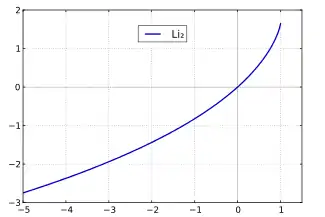Spence's function
In mathematics, Spence's function, or dilogarithm, denoted as Li2(z), is a particular case of the polylogarithm. Two related special functions are referred to as Spence's function, the dilogarithm itself:

and its reflection. For an infinite series also applies (the integral definition constitutes its analytical extension to the complex plane):
Alternatively, the dilogarithm function is sometimes defined as
In hyperbolic geometry the dilogarithm occurs as the hyperbolic volume of an ideal simplex whose ideal vertices have cross ratio . Lobachevsky's function and Clausen's function are closely related functions.
William Spence, after whom the function was named by early writers in the field, was a Scottish mathematician working in the early nineteenth century.[1] He was at school with John Galt,[2] who later wrote a biographical essay on Spence.
Analytic structure
Using the former definition above, the dilogarithm function is analytic everywhere on the complex plane except at , where it has a logarithmic branch point. The standard choice of branch cut is along the positive real axis . However, the function is continuous at the branch point and takes on the value .
Special values
- where is the Riemann zeta function.
In particle physics
Spence's Function is commonly encountered in particle physics while calculating radiative corrections. In this context, the function is often defined with an absolute value inside the logarithm:
Notes
References
- Lewin, L. (1958). Dilogarithms and associated functions. Foreword by J. C. P. Miller. London: Macdonald. MR 0105524.
- Morris, Robert (1979). "The dilogarithm function of a real argument". Math. Comp. 33 (146): 778–787. doi:10.1090/S0025-5718-1979-0521291-X. MR 0521291.
- Loxton, J. H. (1984). "Special values of the dilogarithm". Acta Arith. 18 (2): 155–166. doi:10.4064/aa-43-2-155-166. MR 0736728.
- Kirillov, Anatol N. (1994). "Dilogarithm identities". Progress of Theoretical Physics Supplement. 118: 61–142. arXiv:hep-th/9408113. Bibcode:1995PThPS.118...61K. doi:10.1143/PTPS.118.61.
- Osacar, Carlos; Palacian, Jesus; Palacios, Manuel (1995). "Numerical evaluation of the dilogarithm of complex argument". Celest. Mech. Dyn. Astron. 62 (1): 93–98. Bibcode:1995CeMDA..62...93O. doi:10.1007/BF00692071.
- Zagier, Don (2007). "The Dilogarithm Function". In Pierre Cartier; Pierre Moussa; Bernard Julia; Pierre Vanhove (eds.). Frontiers in Number Theory, Physics, and Geometry II (PDF). pp. 3–65. doi:10.1007/978-3-540-30308-4_1. ISBN 978-3-540-30308-4.
Further reading
- Bloch, Spencer J. (2000). Higher regulators, algebraic K-theory, and zeta functions of elliptic curves. CRM Monograph Series. 11. Providence, RI: American Mathematical Society. ISBN 0-8218-2114-8. Zbl 0958.19001.
